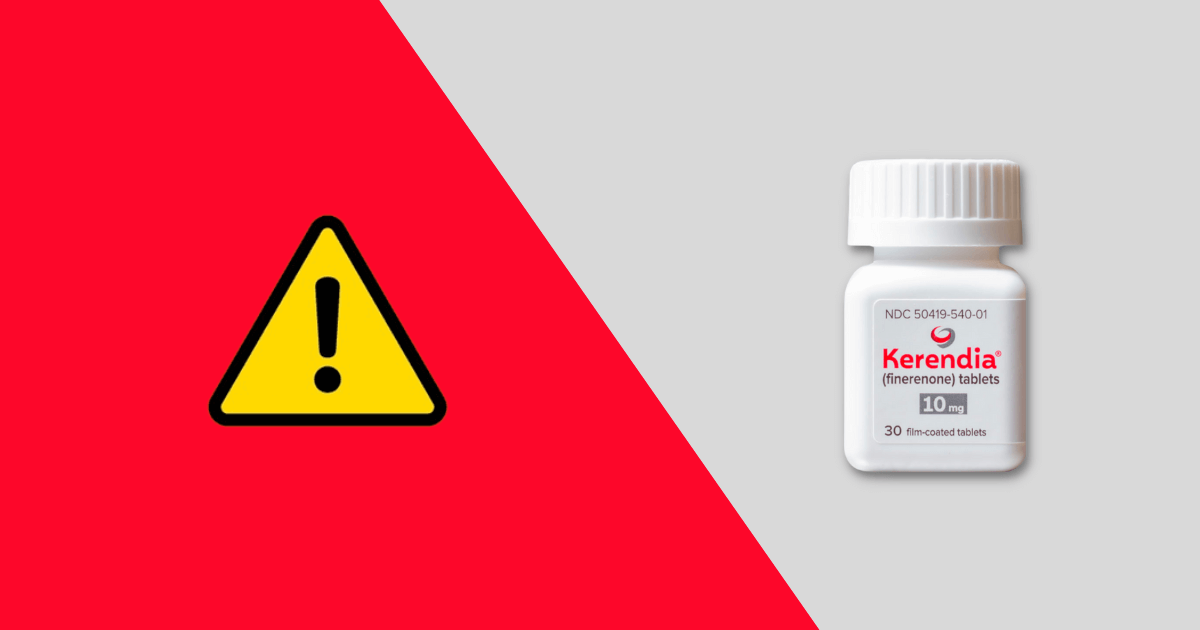Kerendia side effects and how to avoid them
Table of contents
Kerendia is an FDA-approved brand-name medication manufactured by Bayer Pharmaceuticals, Inc. It is classified as a non-steroidal mineralocorticoid receptor antagonist (MRA) and is used to reduce the risk of sustained eGFR decline, end-stage kidney failure, cardiovascular death, heart attack, non-fatal myocardial infarction, and hospitalization for heart failure in adult patients with chronic kidney disease (CKD) associated with type 2 diabetes. While Kerendia is generally well tolerated, there are some potential side effects that people should be aware of. The most common side effects of Kerendia include low blood pressure. Less common but more serious side effects can include low potassium levels.
Learn more about the side effects of Kerendia and what you can do to avoid them.
Is Kerendia a diuretic?
Finerenone, the active ingredient in Kerendia, blocks mineralocorticoid receptors, making it a potassium-sparing diuretic.
Does Kerendia lower blood pressure?
Kerendia causes hypotension as a common side effect.
Kerendia dosage
Kerendia is available in tablet form in the following doses: 10 mg and 20 mg.
The manufacturer recommends a starting dose is 10 mg or 20 mg once per day based on the estimated glomerular filtration rate (eGFR) and serum potassium thresholds. Increase the dose after 4 weeks to the target dose of 20 mg once per day, based on eGFR and serum potassium thresholds.
If you are unable to swallow your tablet, you may crush it and mix it with water or other soft foods such as applesauce. After crushing and mixing the tablet, you should take your dose of Kerendia right away
If you forget to take a dose of Kerendia, take it as soon as you remember. If it is almost time for your next dose, skip the missed dose and take your next dose at the normally scheduled time.
You are advised to read the medication guide provided with this medicine for the drug information and patient information, and always speak with your healthcare provider for medical advice about any changes to your dose so they can monitor and evaluate your condition.
When is the best time to take Kerendia?
Take Kerendia with or without food once daily, as directed by your doctor.
Kerendia side effects
The most common side effects of Kerendia in clinical trials compared to placebo include:
- Hypotension (low blood pressure)
- Hyponatremia
In rare instances, Kerendia can cause more serious side effects. These can include:
- Hyperkalemia – patients with decreased kidney function and higher baseline blood potassium levels are at increased risk, monitor serum potassium levels, and adjust the dose as needed
If you experience any of these serious side effects, stop taking Kerendia and seek medical attention immediately. You are encouraged to report the negative side effects of prescription drugs to the FDA. Visit www.fda.gov/medwatch, or call 1-800-FDA-1088.
Kerendia drug interactions
Kerendia can interact with other medications, including:
- Strong CYP3A4 inhibitors – concomitant use is contraindicated
- Grapefruit or grapefruit Juice
- Moderate or weak CYP3A4 inhibitors
- Strong or moderate CYP3A4 Inducers
- Consult with a physician before using potassium supplements or salt substitutes containing potassium
Before taking Kerendia, be sure to tell your healthcare provider about all of the medications you are taking to ensure they are safe to take at the same time.
Kerendia warnings & precautions
You should not use Kerendia if you:
- Are allergic to the active ingredient finerenone
- Have had an allergic reaction to any of the other ingredients in Kerendia
- Are currently pregnant or are planning to become pregnant
- Are breastfeeding or are planning to breastfeed
Talk to your doctor before using Kerendia if you:
- Are taking any of the medications that could interact with Kerendia
- Have adrenal insufficiency
- Have renal impairment
You should always check with your doctor or pharmacist before taking any medication, including Kerendia, to ensure it is safe for you.
How to avoid Kerendia side effects
The best way to avoid side effects is to take Kerendia as directed by your doctor. Follow your doctor’s instructions carefully, and do not take more or less than prescribed.
If you experience any side effects, talk to your doctor or pharmacist. They may be able to recommend ways to help reduce or prevent some of the side effects.
1. Stick to the recommended dosage
Take your prescribed dose of Kerendia that has been recommended by your healthcare professional. Do not take more or less than prescribed.
2. Monitor your blood sugar levels
If you have diabetes, it is important to monitor your blood sugar levels closely while taking Kerendia. Check your blood sugar levels as directed by your doctor and report any changes to your doctor immediately.
3. Drink plenty of fluids
Drink eight to 10 glasses of water or fluids every day to help prevent dehydration, which can make side effects worse.
4. Don’t skip meals
Eating regular meals and snacks will help to prevent low blood sugar levels (hypoglycemia).
5. Check your feet
If you have diabetes, check your feet for any cuts, sores, or redness regularly. Tell your doctor if you experience problems with your feet while taking Kerendia.
6. Know the signs and symptoms of Kerendia side effects
Signs and symptoms of side effects include low blood pressure. If you experience these symptoms, speak to your doctor for medical advice.
7. Tell your doctor about all medications you’re taking
Be sure to tell your doctor about all other medications you’re taking, including over-the-counter drugs, vitamins, and herbal supplements, as they can interact with Kerendia.
8. Get regular medical checkups
It is important to get regular medical checkups and monitor your medical conditions. Your doctor will monitor your condition and may adjust your dose of Kerendia as needed.
Medically reviewed
A medical professional has reviewed this article.


Jamie Winn, PharmD
Jamie Winn, PharmD
Dr. Jamie Winn received his Doctor of Pharmacy in 2002 from the University of South Carolina College of Pharmacy, Columbia, SC. Jamie is a medical reviewer for NiceRx.

